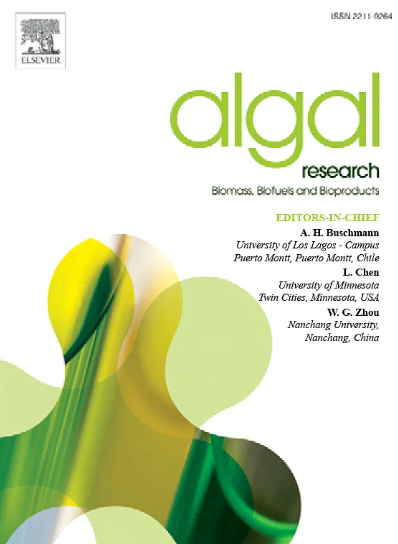Diesel alkanes are incorporated and metabolized in Ulva lactuca activating the expression and activities of antioxidant enzymes and alkane-metabolizing enzymes
IF 4.6
2区 生物学
Q1 BIOTECHNOLOGY & APPLIED MICROBIOLOGY
Algal Research-Biomass Biofuels and Bioproducts
Pub Date : 2025-06-20
DOI:10.1016/j.algal.2025.104166
引用次数: 0
Abstract
To analyze whether the marine alga Ulva lactuca can incorporate and metabolize linear hydrocarbons (alkanes) of diesel, the alga was cultivated without diesel (control) or with 2.5 % v/v of diesel for 168 h (7 d). The concentration of alkanes in the culture medium decreased by 83 % at 168 h of culture while in algal tissue alkane levels increased to a maximal level at 24 h and decrease in 78 % at 168 h of culture. Diesel was constituted by alkanes from C7 to C28, mainly by alkanes C14 to C21 which represents 73 % of total alkanes. In algal tissue, the concentration of alkanes showed a maximal level at 24 h and alkanes C13 and C14 decreased in 100 % at 168 h, alkanes C15 and C16 decreased in 98 and 92 %, respectively at 168 h, and alkanes C18 and C21 decreased around 60 %. Thus, U. lactuca probably metabolizes main diesel alkanes in 60 % to 100 % at 168 h of culture. The incorporation of alkanes induced an oxidative stress condition characterized by an increase in superoxide anions and hydrogen peroxide levels that was rapidly mitigated by the increase in the level of antioxidant molecules such as ascorbate and glutathione, and the increase in activities of antioxidant enzymes such as SOD, AP, DHAR and GR showing maximal activities at 24 h of exposure. The expression and activities of alkane-metabolizing enzymes such as alkane monooxygenase, alcohol dehydrogenase and aldehyde dehydrogenase were increased, indicating that they may be involved in the metabolization of alkanes into fatty acids to fuel basal metabolism. Thus, the alga U. lactuca may constitute a useful biotechnological tool to remove diesel from seawater.

柴油烷烃在乳藻中被吸收和代谢,激活抗氧化酶和烷烃代谢酶的表达和活性
为了分析海藻Ulva lacuca是否能吸收和代谢柴油中的线性烃(烷烃),分别在不含柴油(对照)和添加2.5% v/v柴油的条件下培养168 h (7 d)。培养液中烷烃的浓度在培养168 h时下降了83%,而藻组织中烷烃的浓度在培养24 h时达到最大值,在培养168 h时下降了78%。柴油主要由C7 ~ C28烷烃组成,其中以C14 ~ C21烷烃为主,占总烷烃的73%。在藻组织中,烷烃浓度在24 h时达到最高水平,烷烃C13和C14在168 h时下降100%,烷烃C15和C16在168 h时分别下降98%和92%,烷烃C18和C21下降约60%。因此,在培养168 h时,乳孢菌对主要柴油烷烃的代谢率可能达到60% ~ 100%。烷烃的掺入诱导了氧化应激状态,其特征是超氧阴离子和过氧化氢水平的增加,而抗氧化分子(如抗坏血酸和谷胱甘肽)水平的增加迅速减轻了这种应激状态,抗氧化酶(如SOD、AP、DHAR和GR)的活性增加在暴露24 h时表现出最大活性。烷烃单加氧酶、醇脱氢酶、醛脱氢酶等烷烃代谢酶的表达和活性均增加,表明它们可能参与了烷烃转化为脂肪酸的代谢,为基础代谢提供燃料。因此,海藻可能构成一个有用的生物技术工具,从海水中去除柴油。
本文章由计算机程序翻译,如有差异,请以英文原文为准。
求助全文
约1分钟内获得全文
求助全文
来源期刊

Algal Research-Biomass Biofuels and Bioproducts
BIOTECHNOLOGY & APPLIED MICROBIOLOGY-
CiteScore
9.40
自引率
7.80%
发文量
332
期刊介绍:
Algal Research is an international phycology journal covering all areas of emerging technologies in algae biology, biomass production, cultivation, harvesting, extraction, bioproducts, biorefinery, engineering, and econometrics. Algae is defined to include cyanobacteria, microalgae, and protists and symbionts of interest in biotechnology. The journal publishes original research and reviews for the following scope: algal biology, including but not exclusive to: phylogeny, biodiversity, molecular traits, metabolic regulation, and genetic engineering, algal cultivation, e.g. phototrophic systems, heterotrophic systems, and mixotrophic systems, algal harvesting and extraction systems, biotechnology to convert algal biomass and components into biofuels and bioproducts, e.g., nutraceuticals, pharmaceuticals, animal feed, plastics, etc. algal products and their economic assessment
 求助内容:
求助内容: 应助结果提醒方式:
应助结果提醒方式:


